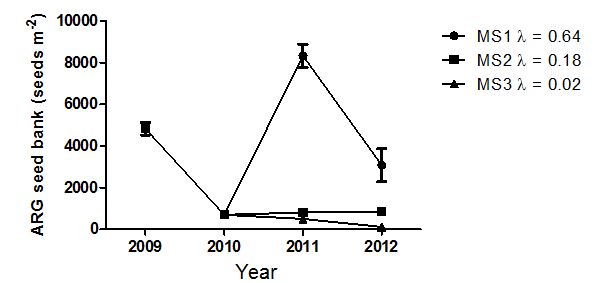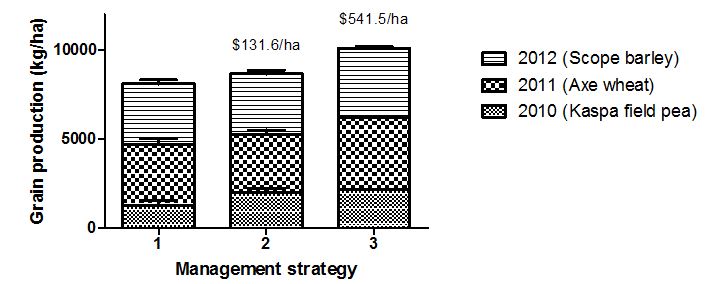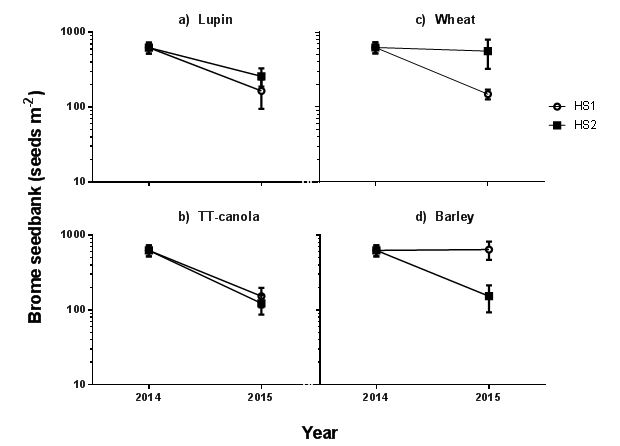Can we beat grass weeds or will they beat us
Author: Christopher Presentation, Peter Boutsalis, Samuel Kleemann and Gurjeet Gill (School of Agriculture, Food & Wine, University of Adelaide) | Date: 11 Aug 2016
ɸExtra technical comment by Protech Consulting Pty Ltd
Herbicide resistant annual ryegrass in the Wimmera and the Mallee
Random resistance surveys have shown that herbicide resistance in annual ryegrass is increasing in Victoria. We randomly surveyed the Wimmera and Mallee for resistant weeds in 2015. For annual ryegrass, particular concern is with increasing resistance to trifluralin, Intervix and glyphosate (Table 1). While trifluralin resistance is becoming widespread in annual ryegrass, we picked up no resistance to any of the other pre-emergent herbicides tested. Glyphosate resistance is now common enough to be picked up in our random weed surveys.
Table 1: Extent of herbicide resistance in annual ryegrass collected in random surveys in Wimmera and Mallee in 2015. Populations are considered resistant if there is more than 20 per cent survival.
| Herbicides tested | Group | Annual ryegrass populations resistant (%) | |
|---|---|---|---|
| Wimmera | Mallee | ||
| Trifluralin | D | 36 | 23 |
| Boxer Gold® | J + K | 0 | 0 |
| Sakura® | K | 0 | 0 |
| Propyzamide | D | 0 | 0 |
| Hoegrass® | A | 80 | 47 |
| Oust® | B | 53 | 68 |
| Intervix® | B | 21 | 44 |
| Axial® | A | 46 | 10 |
| Select® | A | 10 | 0 |
| Glyphosate | M | 9 | 3 |
Integrated management of annual ryegrass
We have over the past few years conducted a number of integrated management trials for annual ryegrass in medium and high rainfall zones. Obtaining high control of seed set is essential for breaking the seed bank of ryegrass. We conducted a multi-year trial at Roseworthy in South Australia to determine the effects of management strategies on ryegrass seed banks. The treatments used are listed in Table 2. After the first year of oaten hay, we used a low, medium and high level of management (Management Strategies 1, 2 and 3 respectively) and measured the seed bank.
Table 2: Long-term weed management strategies investigated for the control of annual ryegrass (ARG) at Roseworthy from 2009 to 2011. All herbicides were applied at recommended label rates and timings.
| Management strategy (MS) | Year | |||
|---|---|---|---|---|
| 2009 | 2010 | 2011 | 2012 | |
| 1 | Oaten hay | Kaspa field pea Trifluralin® IBS |
Axe wheat Boxer Gold® IBS |
Scope barley Trifluralin® IBS |
| 2 | Oaten hay | Kaspa field pea Trifluralin® IBS + Select® POST |
Axe wheat Sakura® IBS |
Scope barley Trifluralin® IBS |
| 3 | Oaten hay | Kaspa field pea Trifluralin® IBS + Select® POST + Roundup PowerMax® CT |
Axe wheat Boxer Gold® IBS + Roundup PowerMax® CT |
Scope barley Trifluralin® IBS |
Abbreviations: IBS, incorporated by sowing; POST, post-emergence; CT, crop-topped.
In this trial, the oaten hay crop reduced the high seed bank of more than 4000seeds/m2 by more than 80 per cent (Figure 1). However, failure to keep pressure on the population (MS 1) caused the population to rebound immediately. Two years of strong control reduced the seed bank by more than 90 per cent and allowed a further reduction with just a pre-emergent herbicide in the wheat crop (MS 3).

Figure 1: Effect of different long-term weed management strategies on pre-sowing (March) ARG seed bank at Roseworthy from 2009 to 2012 under three different management strategies (MS). Bars represent SE of the mean. Seed bank change from 2009 to 2012 expressed as lambda value (λ); (λ value < 1 = seed bank decline; λ value >1 = seed bank increase).
The more intensive management in the field pea phase, and the subsequent reduction in ryegrass seed bank, resulted in increased yields and gross margins in the subsequent wheat and barley phases (Figure 2). MS 3 resulted in an additional $541.50/ha over three years compared with the lowest intensity strategy (MS 1) and was considerably more profitable than MS 2.

Figure 2: Effect of long-term weed management strategies on total grain production (kg/ha) at Roseworthy from 2010 to 2012. Bars represent SE of the mean. Values ($/ha) provided for management strategies 2 and 3 indicate improvement in gross return relative to management strategy 1 ($2237.3/ha). Commodity prices sourced from Farm Gross Margin Guide.
Using sowing date to improve pre-emergent herbicide performance on annual ryegrass in wheat
It has been a long held idea that weedy paddocks should be sown last in the cropping rotation. This is so an extra knockdown application, or a double knock, can be employed to reduce the number of weeds emerging in the crop. This is a perfectly valid practice when post-emergent herbicides can be employed to clean up the remainder of the weed problem and has the added benefit of taking pressure of post-emergent herbicides. However, one consequence of later sowing is that wheat grows more slowly as the soil temperature decreases going into winter, taking more time for canopy closure and hence giving weeds a greater opportunity to use resources. The question is whether in the absence of post-emergent herbicides, sowing the worst paddocks last is still the best strategy.
In collaboration with the Hart Fieldsite Group we conducted trials in 2014 and 2015 with two times of sowing. Scout wheat was sown on 4 May and 2 June 2014 and 30 April and 27 May in 2015. There was an additional knockdown herbicide treatment applied between the two sowing times. Pre-emergent herbicide treatments used at each time of sowing were: nil, Sakura® (118g/ha) and Sakura® (118g/ha) + Avadex Xtra® (2L/ha)ɸ in 2014 and nil, Boxer Gold® (2.5 L/ha), Sakura® (118g/ha) and Sakura® (118g/ha) + Avadex Xtra® (2L/ha)ɸ in 2015.
ɸn.b. this rate is below label rate for use on annual ryegrass.
In 2014, the delay in sowing did not lead to a reduction in the number of ryegrass plants present in crop (Table 3). Where no pre-emergent herbicide was used, there were more head counts from the early time of sowing. In contrast, where effective pre-emergent herbicides were used there was no difference in the number of seed heads produced. Wheat yield from TOS1 was 4.15t/ha and from TOS2 was 2.93t/ha.
Table 3: Annual ryegrass present in crop and seed heads at maturity for two times of sowing (TOS) at Hart in 2014. For each measurement, different letters indicate significant differences in means.
| Pre-emergent herbicide |
Plant counts/m2 (8 Aug) | Head counts/m2 (10 Oct) | ||
|---|---|---|---|---|
| TOS1 | TOS2 | TOS1 | TOS2 | |
| Nil | 59 a | 77 a | 350 a | 164 b |
| Sakura®(118g/ha) | 8 b | 8 b | 39 c | 41 c |
| Sakura®(118g/ha) + Avadex Xtra® (2L/haɸ) |
3 b | 3 b | 32 c | 9 c |
ɸn.b. this rate is below label rate for use on annual ryegrass.
The 2014 season in SA ended with an exceptionally dry spring period, although there was enough stored early moisture to allow most crops to finish well. There had also been abundant winter rainfall that helped pre-emergent herbicides to work well.
We repeated this trial in 2015 with similar results (Table 4). Conditions were much drier in 2015, particularly in spring, leading to lower annual ryegrass head numbers. Yields were also lower in 2015; however, the early TOS (2.2t/ha) still had significantly greater yield than the later TOS (1.5t/ha).
Table 4: Annual ryegrass present in crop and seed heads at maturity for two times of sowing (TOS) at Hart in 2015. For each measurement, different letters indicate significant differences in means.
| Pre-emergent herbicide | Plant counts/m2 (10 Jul) | Head counts/m2 (16 Oct) | ||
|---|---|---|---|---|
| TOS1 | TOS2 | TOS1 | TOS2 | |
| Nil | 18 a | 6 b | 45 a | 44 a |
| Boxer Gold®(2.5L/ha) | 3 bc | 1 bc | 5 bc | 9 bc |
| Sakura®(118g/ha) | 1 bc | 2 bc | 3 bc | 13 bc |
| Sakura®(118g/ha) + Avadex Xtra® (2L/haɸ) | 0 c | 1 bc | 0 c | 15 b |
ɸn.b. this rate is below label rate for use on annual ryegrass.
Integrated management of brome grass
Integrated management of brome grass is much more difficult than integrated management of annual ryegrass. Imidazolinone herbicides, such as Intervix remain the best herbicide options available for brome grass; however, they are Group B herbicides and at high risk of resistance. We conducted a trial of integrated management strategies for brome grass at Balaklava in SA over the past three years. The trial consisted of four crop options in rotation with two strategies in each of the crops (Table 5). Clearfield options were used for the cereal phase of the rotation.
Table 5: Herbicide strategies investigated for the management of brome in lupins, TT-canola, wheat and barley at Balaklava.
| *Cropping phase | Herbicide strategy (1 & 2) | |
|---|---|---|
| HS1 | HS2 | |
| Lupins | Simazine pre Haloxyfop post | Simazine pre
Haloxyfop post Paraquat crop-top |
| TT-canola | Atrazine pre Atrazineɸaplus Haloxyfop post | Propyzamide pre
Atrazine plus Haloxyfop post Glyphosate crop-top |
| Wheat | Trifluralin pre Intervix post | Sakura plus Avadex Xtra pre
Glyphosateɸb crop-top |
| Barley | Trifluralin plus metribuzin pre | Trifluralin pre Intervix post |
*Wheat and barley cultivars are tolerant to imidazolinone herbicides.
ɸaListed on the label as having suppression of brome grass; ɸbWeedmaster DST is the glyphosate product registered for this use.
The two break crops in the rotation were able to reduce the brome grass seed bank, regardless of the strategy used. However, for cereals the brome grass seed bank was only reduced when Clearfield crops and Intervix herbicide were used (Figure 3). Previous research has demonstrated that you need two consecutive years of good control of brome grass to manage this weed species. Where we had back to back break crops (lupins followed by canola) followed by a Clearfield cereal, we were able to reduce brome grass seed production in 2015 to zero. Clearly it is important to use the last remaining Intervix applications on brome grass in the cereal part of the rotation and following a break crop to achieve the best long term result.

Figure 3: Change in brome grass seed bank in response to herbicide strategy (HS1 and HS2) in lupin (a), TT-canola (b), wheat (c), and barley (d) crop phases at Balaklava in 2015. Detailed description of herbicide strategies are presented in Table 5. Vertical bars represent SE. The initial brome grass seed bank was 626 seeds/m.
Management of herbicide residues in the soil
Using soil persistent herbicides can provide very effective weed control; however, issues can arise when sensitive crops are planted in the next season. The main factors that influence whether crop damage occurs are: rainfall from application to sowing, temperature when the soil is wet, soil pH, soil organic matter, the sensitivity of the crop to the herbicide and the relative persistence of the herbicide in the soil. Risk of damage to subsequent crops is greatest when conditions after application are dry from spring until autumn.
Herbicides can be broken down by chemical and/or microbial means. Both require moisture and temperature to be effective. Herbicides break down more slowly in winter when moisture may be available, but temperatures are low. In a Mediterranean climate, there is usually little or no herbicide breakdown over summer, where temperature is high, but there is no moisture available in the top soil. Most herbicide breakdown will occur in spring and autumn.
To achieve sustained breakdown of herbicides, the top 2cm of the soil needs to be moist for a period of seven days or more. This is because in summer, the soil microbes shut down due to lack of water and it takes time for their populations to build up again. Small rainfall events in summer will be quickly evaporated from the topsoil, so as a general rule the rainfall events of less than 10mm in summer should not be counted towards the amount of rainfall required for herbicide breakdown. It is those larger events, typically those of 25mm or more, which will contribute most to herbicide breakdown.
Soil type and soil pH are also important as they will affect how far the herbicide moves down the soil profile. Most of the microbial activity occurs in the top few centimetres of the soil and if the herbicide moves below this layer, it may be broken down more slowly. For example, sulfonylurea herbicides are much more mobile in alkaline soils, and this contributes to their longer persistence in alkaline soils. Soil organic matter is important as it provides food for the microbes. Microbial populations are typically smaller in soils with low organic matter than in those with higher organic matter.
Following a dry spring and summer, it is generally those large rainfall events in autumn that do most of the work in breaking down herbicides. The larger these events are and the earlier they occur, the lower the risk of crop damage. One added risk is that the first large rainfall event after a long dry summer will release herbicides into the soil water quickly. Planting too soon after that first large rainfall event can result in greater crop damage than waiting for a week to sow. The re-cropping intervals on product labels are a good guide to the likely risks of crop damage. When in doubt, it is good practice to sow a more tolerant crop.
Acknowledgements
The research undertaken as part of this project is made possible by the significant contributions of growers through both trial cooperation and the support of the GRDC, the author would like to thank them for their continued support.
Contact details
Christopher PrestonUniversity of Adelaide
School of Agriculture, Food & Wine, University of Adelaide , PMB 1 Glen Osmond SA 5064
08 8313 7237
christopher.preston@adelaide.edu.au
Was this page helpful?
YOUR FEEDBACK
